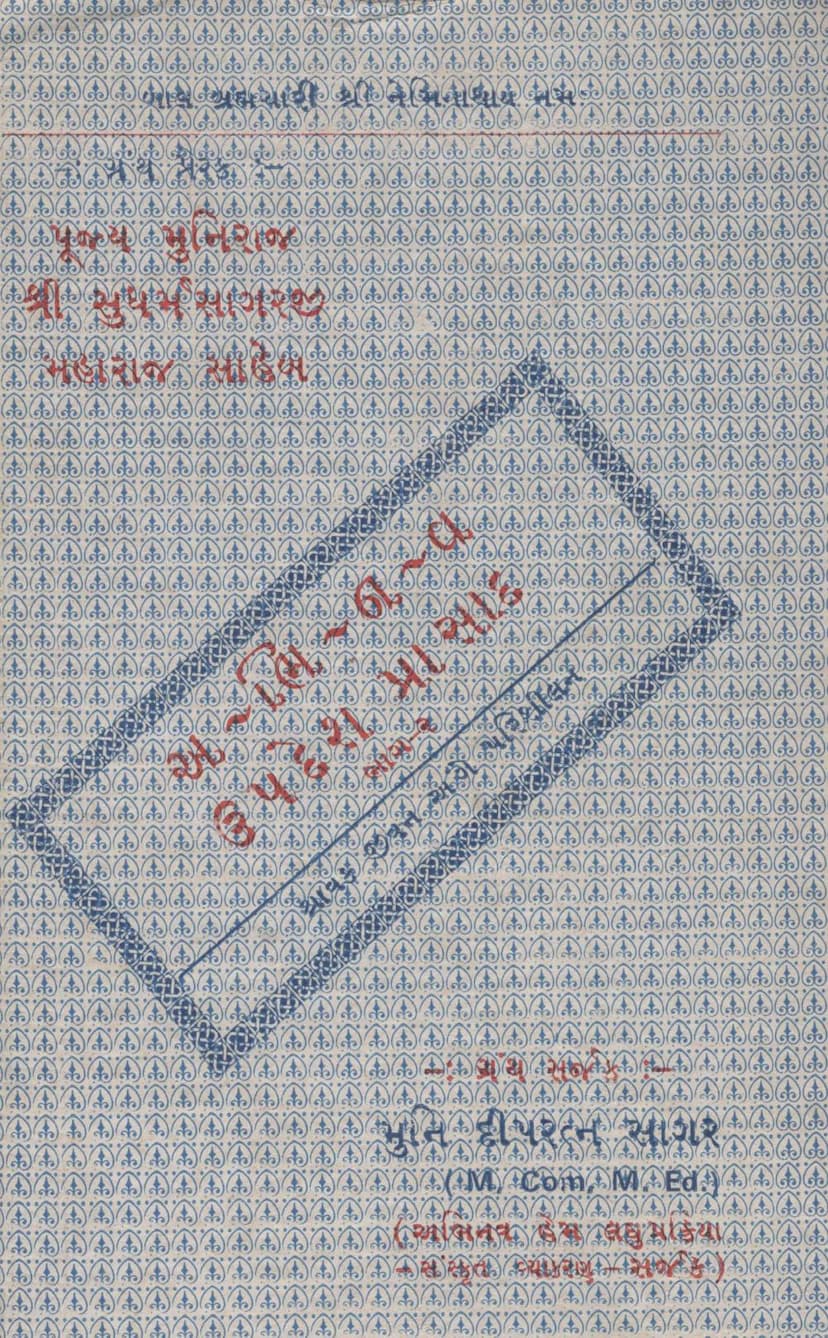Abhinav Updesh Prasad Vyakhyano Part 02
Added to library: September 1, 2025

Summary
This is a comprehensive summary of the Jain text "Abhinav Updesh Prasad Vyakhyano Part 02" by Dipratnasagar and Deepratnasagar, published by Abhinav Shrut Prakashan. The book is a collection of spiritual discourses (Vyakhyanos) focused on the life and duties of a householder (Shravak) from a Jain perspective.
Overall Theme:
The book serves as a guide for lay Jains, elaborating on their spiritual and ethical responsibilities in daily life. It emphasizes the importance of righteous conduct, adherence to vows, and the practice of various spiritual disciplines to achieve liberation (Moksha). The discourses are rich in philosophical concepts, scriptural references, and relatable anecdotes.
Key Concepts and Chapters Covered:
The book is structured around various aspects of Jain ethics and spiritual practice, presented as a series of discourses or "Parishilan" (contemplations). Based on the table of contents and the provided page snippets, the major themes and chapters include:
-
The Importance of Giving (Daan):
- "Vaave ane Lanae" (Sow and Reap): This foundational concept highlights the principle of karma, where actions (giving) have consequences (reaping). It stresses that what is given with a pure heart and to deserving recipients (Supatra) yields auspicious results, even in the hereafter.
- The Significance of Daan: Emphasizes that wealth is meant for use and distribution, not just hoarding. It quotes a proverb suggesting that what is given is retained, what is eaten is lost, and what is not used is ultimately destroyed.
- Supatra Daan (Giving to the Worthy): Explains the importance of identifying the right recipients for donations, highlighting the supreme merit in giving to the virtuous and deserving.
- Abhayadaan (Gift of Fearlessness): Discusses the profound merit of offering security and protection to living beings, freeing them from fear.
- Other Forms of Daan: Mentions various other types of donations, including Vasti Daan (donation of residential places for ascetics).
-
Conduct and Character (Sheel & Brahmacharya):
- The Essence of Sheel: Defines Sheel as the practice of virtue and good conduct, emphasizing its role in achieving eternal happiness.
- Sheel-Chaturth Vrat (Sheel – The Fourth Vow): Specifically highlights the significance of Brahmacharya (celibacy or chastity) as a key vow.
- Sheel-Sadachar: Connects Sheel with righteous living and ethical behavior.
-
Ascetic Practices (Tap Dharma):
- The Greatness of Tap: Underscores Tap (asceticism) as a powerful means for shedding karma and progressing towards liberation.
- Anashan Tap (Fasting): Details the practice of fasting as a primary form of Tap, emphasizing its spiritual benefits.
- Udarari Tap (Moderation in Food): Explains the concept of eating less than one's fill as a form of Tap.
- Vritti Sankshhep Tap (Limiting Livelihood/Possessions): Discusses the practice of reducing one's needs and possessions as an ascetic discipline.
- Ras Tyag (Abstinence from Desirable Tastes): Focuses on controlling the palate and renouncing refined tastes as a form of Tap.
- Kaya Klesh Tap (Enduring Bodily Hardship): Explains the practice of willingly enduring physical discomforts and austerities for spiritual growth.
- Samlinata Tap (Control over Senses/Self-Control): Highlights the importance of controlling one's senses and inner impulses.
- Other Forms of Tap: Mentions Prayshchitt (penance), Vinay (humility/respect), Vaiyavachch (service to ascetics), Swadhyay (self-study/scriptural study), Dhyan (meditation), and Utsarg (renunciation) as integral parts of Tap Dharma.
-
The Importance of Inner States (Bhavna):
- Bhav-The Cause of Bondage and Liberation: This central theme emphasizes that one's inner state (Bhav) is the root cause of both karmic bondage and liberation. Positive thoughts and intentions lead to auspicious karma, while negative ones lead to inauspicious karma.
- Anitya Bhavna (Contemplation of Impermanence): Focuses on the transient nature of worldly existence, relationships, and possessions, encouraging detachment.
- Asharan Bhavna (Contemplation of Helplessness): Highlights the idea that ultimately, one is alone in facing the consequences of their actions and in their spiritual journey.
- Sansar Bhavna (Contemplation of the Cycle of Birth and Death): Explores the endless cycle of transmigration and the suffering involved.
- Ekattva Bhavna (Contemplation of Oneness/Solitude): Emphasizes the fundamental aloneness of the soul in its journey.
- Other Bhavnas: The text also touches upon Ashuchi (impurity), and implies other essential Bhavnas for spiritual progress.
-
Specific Virtues and Practices:
- Abhayadaan (Fearlessness): Elaborates on protecting living beings from fear as a supreme act of charity.
- Vasti Daan (Donation of Residence): Explains the significance of providing shelter and lodging for ascetics, considering it a comprehensive form of giving.
- Sheel (Virtue/Chastity): Discusses Sheel as a priceless ornament that brings prosperity, strength, and spiritual development.
- Swadhyay (Self-Study/Scriptural Study): Elevates Swadhyay as the most excellent form of Tap, essential for realizing the self and achieving liberation.
- Dhyan (Meditation): Highlights meditation as a means to control the mind and achieve spiritual goals.
- Utsarg (Renunciation): Discusses the principle of letting go of attachments and material possessions.
- Pratyashchit (Penance/Expiation): Explains the process of purifying oneself from past wrongdoings.
- Vinay (Humility/Respect): Emphasizes the foundational importance of humility and respect towards the enlightened ones and spiritual teachers.
- Vaiyavachch (Service): Details the importance of serving ascetics and the virtuous, highlighting its karmic benefits.
Authoritative Tone and Purpose:
The book adopts an authoritative and instructive tone, drawing heavily from Jain scriptures and philosophical principles. It aims to educate and guide householder Jains on how to live a meaningful and spiritually fulfilling life, leading ultimately to Moksha. The author, Muni Shri Deepratna Sagar, likely aims to provide practical wisdom for contemporary householders, making the ancient Jain teachings accessible and relevant.
Publisher and Context:
Published by Abhinav Shrut Prakashan, the catalog link suggests a dedication to preserving and disseminating Jain knowledge. The title itself, "Abhinav Updesh Prasad Vyakhyano Part 02," indicates that it's a continuation of a series of spiritual discourses, offering "new" or "modern" (Abhinav) interpretations and guidance. The presence of financial contributors ("Dravya Sahayak") from various Jain Sangh communities indicates a collaborative effort to make this spiritual knowledge available to the public.